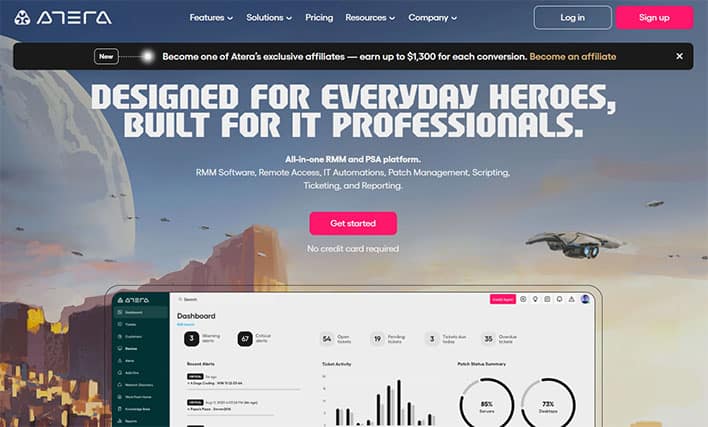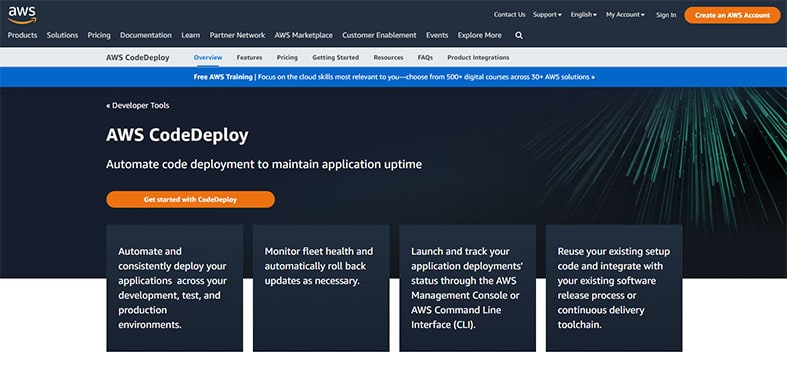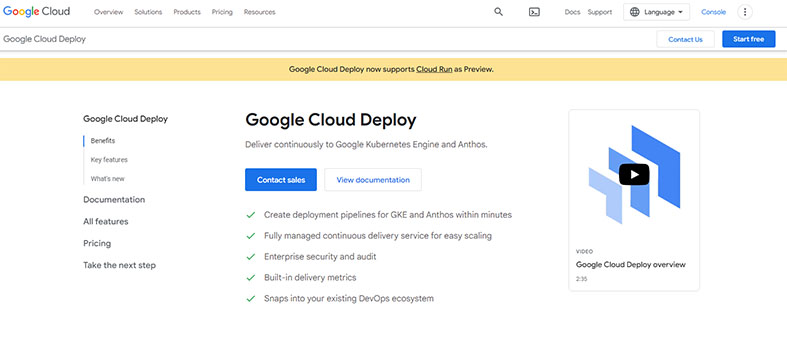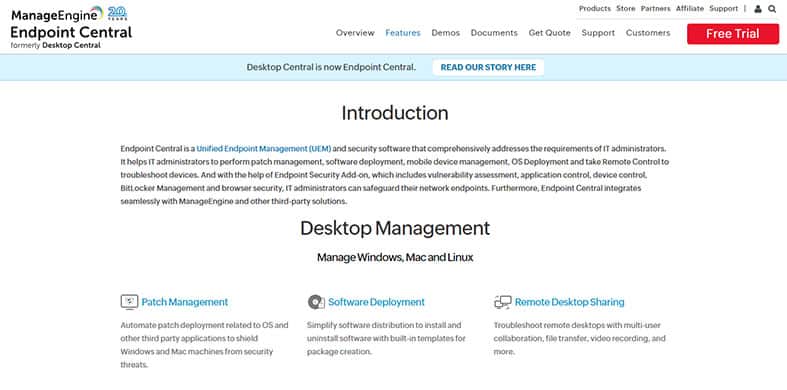Developers and organizations utilize various tools throughout software deployment procedures to achieve the intended outcomes. But what are software deployment tools? Software deployment tools facilitate the installation of software on all network endpoints. These technologies automate tasks, schedule activities and enable developers to collaborate on projects, monitor progress and manage modifications. The varied roles of software deployment tools allow developers to concentrate on other crucial tasks. Given the plethora of deployment software available today, selecting the most effective deployment tool may be difficult.

Here are the 10 best software development tools.
- Syxsense Manage (Best Overall)
- Jenkins (Best Free)
- Atera (Best CI/CD solution)
- Octopus Deploy
- AWS CodeDeploy
- NinjaOne
- Atlassian Bamboo
- GitLab CI/CD
- Google Cloud Deploy
- ManageEngine Endpoint Central
Table of Contents
1. Syxsense Manage
Syxsense Manage is a cloud-based software management tool that enables users to set up and manage both in and out-of-network endpoints. Syxsense Manage improves software distribution by centralizing cloud-based software installations. This method facilitates the sharing of files between systems to increase bandwidth efficiency.

The key features of Syxsense Manage are Patch management, remediation, mobile device management, remote control, compliance report, security scanner, dashboards and reports, feature upgrades, software distribution, discovery agent, data monitoring and activity tracking.
The pros of Syxsense Manage are user-friendliness, an automatic system scanning for updates, multiple channel communication support, cloud-based architecture, simple configuration, complete visibility and cross-platform compatibility. Syxsense Manage allows users to schedule installation and updates at any convenience. This unique capability permits IT professionals and service providers to work remotely.
Syxsense Manage has some cons, including the demand for many steps to create a task, the need for improvement in report execution, the shortage of documentation to guide users and the lack of support for the latest updates.
Note:
The price of Syxsense Manage is available upon request from the Syxsense sales team. The purpose of the quote is to give a price plan that meets the needs and objectives of the business. For instance, when giving a quote, one of the key things to answer is the number of endpoints the organization wants to manage.Syxsense Manage is cloud-based and managed on Microsoft Azure. Syxsense Manage supports several platforms: Windows, Mac, Linux, iOS and Android. This software deployment tool has a 14-day free trial.
2. Jenkins
Jenkins is a free and open-source software deployment platform ideal for small and large enterprises. Jenkins is an automated server-based application that facilitates software development processes. The tool helps automate software development tasks associated with building, testing, and deploying, facilitating continuous integration and delivery.

Jenkins’s key features are continuous integration and delivery, being open-source software, simple installations, user-friendly plugins and simple task distribution across many workstations.
The pros of using Jenkins as a software deployment solution include accurate data support, support for numerous programming languages, such as Java and Python, community support, a good user interface and significant flexibility.
Jenkins’ cons include problems with plugin updates, a cumbersome installation and configuration procedure, unpredictable expenses and maintenance challenges.
3. Atera
Atera is a cloud-based software management solution for remote monitoring and management for small to medium-sized IT enterprises. Atera supports time and expense monitoring, billing and invoicing and document management.

The key features of Atera are effective software administration, automation, unlimited device support, patch management, remote monitoring and management, network discovery, hotline for IT departments, real-time monitoring and integrations.
Atera’s pros include robust encryption employing a 256-bit encryption protocol, frequent updates, good customer communication, prompt notifications, customized system alarms, simple operation, hardware monitoring and a wide range of application connectors.
The cons are limited Mac support, a sluggish status update and the need for better user-friendly documentation.
Atera provides three pricing tiers for MSP and IT, each with a unique price structure. The MSP prices include $99, $129 and $169 per month for a yearly plan for the Pro, Growth and Power packages. The IT package prices are $149, $169 and $199 per month for a yearly plan for the Professional, Expert and Master packages.
| Pro | Growth | Power |
|---|---|---|
| $99 per month | $129 per month | $169 per month |
| Professional | Expert | Master |
|---|---|---|
| $149 per month | $169 per month | $199 per month |
The Atera software deployment tool is compatible with Windows, Mac, Linux, iPhone, iPad and Android operating systems. The program also offers a 30-day free trial, allowing customers to evaluate the software before making a financial commitment.
4. Octopus Deploy
Octopus Deploy is a cloud-based and on-premise software deployment automation solution. Small and large enterprises can rely on this tool to simplify even the most complex software deployments.

Octopus Deploy’s key features include platform support, user-friendliness, an intuitive interface, simple integrations with many platforms, deployment scheduling, management of sensitive variables and multi-tenancy.
The pros of utilizing Octopus Deploy include a user-friendly interface, adjustable deployment methods, automated deployments, deployment logging, dependable support and community, feature-rich software and simple installation.
The cons include a lack of actual statistics and analytics for managing active deployments and historical data, complex configuration with Azure, a cluttered dashboard, expensive plans, and the need for technical expertise for efficient operation.
The pricing plan varies based on the number of deployments. The Cloud version costs $10 for the Community plan, $12 per target for the Professional plan and $18 per target for the Enterprise plan per month. The Server version is free for the Community plan and costs $12 per target for the Professional plan and $18 per target for the Enterprise plan paid monthly.
| Community | Professional | Enterprise |
|---|---|---|
| $10 per month | $12 per month | $18 per month |
| Community | Professional | Enterprise |
|---|---|---|
| $0 | $12 per month | $18 per month |
Octopus Deploy is compatible with client/desktop versions of Windows and Linux.
Octopus Deploy provides users with a 30-day free trial.
5. AWS CodeDeploy
AWS CodeDeploy is an automated software deployment solution that enables deployment to many services, including Amazon EC2, AWS Lambda and on-premises servers. AWS CodeDeploy simplifies the deployment of new features for small and large businesses.

The key features include automated deployments, reduced downtime during application deployment, management of the complexity of application upgrades, centralized control, simple adaptation and notifications.
AWS CodeDeploy’s pros include free usage, compatibility with various apps, an automatic deployment procedure, an easy-to-use interface and a unified development team interface. AWS CodeDeploy has deployment cons: trouble dealing with multi-tier apps and inability to adjust deployment order throughout various deployment procedures.
Note:
People can start using AWS CodeDeploy at no cost and pay $0.02 per on-premises instance update.AWS CodeDeploy supports several operating systems, including Amazon Linux, Red Hat Enterprise Linux, Ubuntu Server and Microsoft Windows Server. Since the AWS CodeDeploy agent is open-source software, users can also test the application on various operating systems.
6. NinjaOne
NinjaOne is an all-inclusive remote software management solution that enables enterprises to deploy, patch, remove and monitor programs at scale without requiring a company network or domain. The solution also includes essential software management tools for flawless deployment.

The key features of NinjaOne are easy software removal, Windows program patching, auto-remediation of failed applications, automatic software deployment, dependable application security and cloud backup.
NinjaOne’s pros include efficient patch management, a dependable monitoring asset for organizations, easy configuration, adaptability in customizing, rapid deployment, an appealing interface and documentation to facilitate use. Despite all the advantages, there are cons to adopting NinjaOne. Many features may be difficult or overwhelming to operate, and there is no free version.
Note:
The pricing structure of NinjaOne is based on the user’s needs and device. Users can contact the sales team for a customized price quote based on the organization’s needs.NinjaOne supports popular platforms, simplifying application deployment to Windows, Mac and Linux endpoints. NinjaOne also offers a free trial but no free plans.
7. Atlassian Bamboo
Atlassian Bamboo is a continuous integration and delivery pipeline that provides small and large enterprises with resilience, dependability and scalability. The tool is multipurpose, ranging from coding to deployment, and can conduct simultaneous automated tests.

The key features of Atlassian Bamboo are workflow automation, integrated disaster recovery, business integrations and incident investigation.
The pros of Bamboo are its easy-to-use web interface, excellent integrations, many plugins, reliability, enforcement of easy communication protocols within the team, easy integration with Bitbucket and Jira, lightweight software, ease to customize, easiness to set up and flexibility with program language.
The cons of Atlassian Bamboo are expensive plugins, a lack of a free plan and a lack of beginner-friendly functionality. Bamboo prices depend on agents rather than users. The higher the number of agents, the more processes can be executed concurrently, whether being steps in the same build or steps in different builds.
A plan for teams of any size is $1,200 per month and includes limitless jobs and one remote agent. Clients can choose plans with up to 2,000 remote agents.
| For teams of any size |
|---|
| $1,200 per month |
Atlassian Bamboo supports Microsoft Windows, Linux and macOS operating systems. Bamboo offers a free 30-day trial for testing purposes.
8. GitLab CI/CD
GitLab CI/CD is an automated software deployment platform that employs the continuous methodologies of Continuous Integration (CI), Continuous Delivery (CD) and Continuous Deployment (CD). In addition to preventing bugs and code errors, automated deployment eliminates human interaction.

The key features of Gitlab CI/CD are simple planning of project deployment, scalability, being open-source, an easy-to-understand interface, the minimization of integration issues and compatibility with the whole DevOps lifecycle.
GitLab CI/CD’s pros include increased developer productivity through automation, an easy fix and recovery procedure, real-time feedback, simple collaboration, project planning, usability, security, tool integration and performance monitoring. The cons include costly plans, a faulty merge request, a complicated menu and an interface that requires improvement.
GitLab CI/CD price structure consists of two tiers: Premium and Ultimate, priced at $19 and $99 per user per month annually invoiced, respectively. There is a free trial and a free plan at GitLab. GitLab is compatible with Ubuntu, Debian, AlmaLinux, CentOS, OpenSUSE, Amazon Linux and Raspberry Pi.
| Premium | Ultimate |
|---|---|
| $19 per month | $99 per month |
9. Google Cloud Deploy
Google Cloud Deploy is a deployment solution for infrastructure that automates the development and maintenance of Google Cloud resources. The service supports repeatable deployments.

One of the key features of Google Cloud Deploy is support for customizable templates and configuration files to make deployments using a range of Google Cloud services set to work together, such as Cloud Storage, Compute Engine and Cloud SQL. Other key features include a repeatable deployment procedure, broad network access, a focus on the application, a template-driven architecture and automated service.
Google Cloud Deploy’s pros include layered security, scalability, redundant backup, adequate bandwidth, simple control, uniform structures, the ability to deploy numerous resources, remote control, rapid deployment, dependability and a user-friendly administration panel. The cons include a lack of sufficient documentation on end-to-end API usage, the absence of simultaneous updates and inadequate customer service, particularly phone help.
Note:
Cloud Deploy is free to use. But to have more than one active delivery pipeline, the cost of each is $15 per month. The Code Deploy is available as a free trial on Google Cloud. Users of the Google Cloud Platform can access the Deployment Manager at no additional cost. Resources deployed with the Deployment Manager may incur fees.The Google Cloud Deploy is a cloud-based service compatible with multiple operating systems.
10. ManageEngine Endpoint Central
ManageEngine Endpoint Central, known initially as Desktop Central, is a comprehensive endpoint management and security software that caters to the needs of IT services and administrations. This solution assists with device administration, software deployment, mobile device management, operating system deployment, remote control and debugging.

The key features of ManageEngine Endpoint Central are patch management, software management, OS deployment, power management, mobile device management, security management, audits and reporting, vulnerability management and integration with other ManageEngine products.
ManageEngine Endpoint Central’s pros include intuitive dashboards, compatibility with various platforms, patch management, ease of use, simple remote control procedure, time-saving capabilities and licensing compliance check. The cons include a laborious update procedure, laggy remote browser access and inadequate customer service.
Note:
The pricing plan is only accessible upon request. Prices go from $104 to $57,113, depending on many features. People must fill out a form to receive a tailored quote for the cloud or on-premises solution that best meets the business’ needs.ManageEngine Endpoint Central is compatible with Windows, Mac and Linux operating systems. The service offers a free 30-day trial that manages an unlimited number of endpoints.
Note:
Prices may differ from the ones shown as new plans and deals are launched on a regular basis. Please be sure to check the most current price on the official website.What Is Software Deployment?
Software deployment refers to making software accessible to the intended user. Developers use various technologies to automate and expedite the deployment process. Software deployment helps to achieve optimal IT environment optimization, security and compatibility. Software deployment also facilitates accomplishing business needs via updates, patches, functionality and others.
What Are the Stages of Software Deployment?
Software deployment is essential to the efficient operation of any business. So developers can manually or automatically launch deployment to accomplish the desired result. There are three stages of software deployment: deployment, testing and monitoring.
What Are Software Deployment Tools?
Software deployment tools are services, software or solutions that simplify and expedite the software deployment process. These tools increase developer efficiency and guarantee error-free software management procedures. Software deployment technologies enable developers to collaborate remotely on a project and monitor and manage workflow progress. There are numerous deployment solutions for software, including Jenkins, Google Cloud Deploy, Atera and others.
What Is the Importance of Software Deployment Tools?
The primary purpose of software deployment tools is to improve deployment efficiency and eliminate errors from the entire process. Besides saving time, software deployment technologies enable simultaneous deployment, which also saves time. Software deployment solutions improve visibility and ensure software security through robust encryptions.
What Should You Look For in a Software Deployment Tool?
Although software deployment tools are crucial to software management procedures, individuals must select the most effective software tool. A software deployment tool should include support for operating systems, active plugins, low downtime, security features, convenience of use, support for usage purposes, compatibility with many platforms and automation capabilities, among other characteristics.
How Do Software Deployment Tools Work?
The purpose of software deployment tools is to ensure that the process by which applications, modules, updates and patches are distributed from developers to end users is quick and precise. The deployment processes determine the efficiency and quality of a product’s update. Developers can select manual or automatic methods. The procedure must be perfect, error-free and secure.
Is It Necessary To Use Software Deployment Tools?
Yes, using a software deployment tool is essential when a business controls a network, and software is required to be distributed to all endpoints. A software deployment tool facilitates the deployment of software development processes. The deployment also increases developer efficiency and remote application deployment speed.

